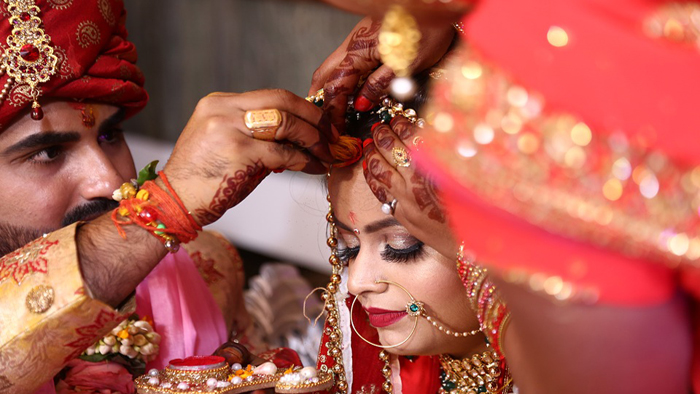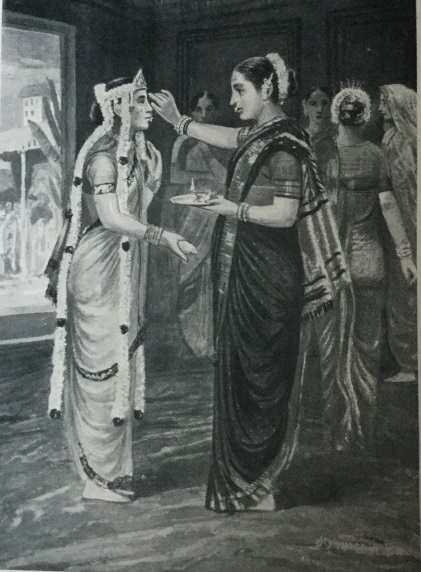Hindu and Muslim Wedding in India

A marriage ceremony in India is a picturesque and pretty rite and feasting for days on end is the order of the day. But the chief incident of a better-class Hindu marriage ceremony consists of what is called the Bhaunri – the seven steps are taken in unison. All this is symbolic. The seven steps are the seven grades of life. Compare this with the seven ages of life in your own immortal bard, or the seven sacraments of the Roman Catholic Church, or the seven planets of ancient astronomy, after which the names of the week were named.
Among the Muhammadans, these picturesque ceremonies are not recognized. In the first place, the parties are a little older. In the second place, the Mohammadan marriage is a civil contract in which neither party merges its identity with the other.
The Hindu is bound to invite his whole caste or community, within a reasonable distance, to his wedding festivities; The Mohammadan only his select friends. The Mohammadan ecclesiastical ceremony is of the simplest description, as simple as that among the Society of Friends.
Many of the Muhammadan families restrict themselves to the ecclesiastical ceremony, but the majority have adopted or inherited in addition to the customs of the country. Some even use a modified form of the Bhaunri. Prolonged feasts and ceremonies, with music or noise (whichever you prefer to call it and martial-looking processions ), are quite common.
A wealthy family’s bridal party would be mounted on palanquins, horses, elephants, and chariots, such as Abhimanyu might have used in the Great War. Coins would be scattered on the march, to be scrambled for by boys and youths of the poorer classes.
Fireworks
Fireworks play a very important part in the rejoicings incident to an Indian marriage. Most of the firework makers drive a roaring trade in the marriage season, and earn the best of their profits during that time, hibernating during the rest of the year. Thus marriage is good for trade.
The marriage season is limited to two or three months of the year, generally in the spring: but the heavenly aspect varies in different years. When the stars are most propitious there is a regular marriage boom, with a concomitant boom in the trade-in of fireworks, clothes, and fancy articles. But the stars may also ruin trade if they frown on the astrologers and indicate a slump in the marriage market.
If we may trust the fidelity of Hogarth, English popular marriage customs were not so very different in the eighteenth century from what we may observe every day in India at the present time. Take the wedding scene in the series of pictures entitled “Industry and Idleness.” The industrious apprentice has, at last, won the band of his master’s daughter. At the festivities the proud bridegroom is seen offering the drummer — shall we call him tomboy? — bakshish in time form of hard coin.
The butchers are there with the marrow bones and cleavers, just as you would find the representatives of different trades following an Indian bridal party, each with the emblems of his trade — the sweeper with his broom, and the barber with his bag. You have further in Hogarth the beggar with his merry ballad but mournful face. An Indian Bhat might well have sat for a model. But what is this? – a poor woman with a child in one wallet and “the crumbs that do fall from the master’s table” in another. Evidently, a Chamarin comes to assert her claims on the lord of the feast.
Bride’s Dress
How is the bride dressed, and what does she look like? Dare I attempt a word picture? It would be more satisfactory if a gifted artist’s brush were allowed to tell its own tale. I have the honor to possess a picture in oils, The Hindu bride,” painted by Mrs. Barber, which won a medal at the Simla Fine Arts Exhibition some years ago. It is a symphony in colors, but most difficult to reproduce. Let us try to gain an idea of the bride’s appearance by means of a feeble description.

There is the girl, with the brightest of black eyes, and a face more round than oval. The white of those eyes is of dazzling purity, like the modest little soul that looks out of them, but you can scarcely see the eyes. The cloth which serves both for headgear and body garment is drawn closely over the face. It would be difficult to name the color of this piece of drapery.
It is semi-transparent and lets you see the glory of the raven hair and the sparkle of the jewels worn on the person, but it adds its own contribution of color to the general harmony. Perhaps we should not call it color: Pas la couleur, rien que la nuance, as Paul Verlaine would say. It is a suggestion in light blue silk gossamer, with a border worked in gold and silver threads, which both stiffens and enriches the airy stuff.
The jewelry errs on the side of profusion, but jewelry there is no trace of vulgarity. The drapery, which, in concealing it, heightens its effect, gives it a subdued tone where it might otherwise “cry aloud”. A row of little pearls hooked into one of the plaits of hair covers the parting of the hair in the middle. From it hangs on the forehead a flat little pendant of pearls, rubies, and moonstones, set in gold. This pendant also fits into the scheme of the caste mark if the girl is Hindu otherwise it is artistically meaningless.
The hair is gathered into a knot behind, and a garland of the sweet-smelling Bela flowers is intertwined with it snowy white on raven black, filtered through the blue of the drapery. From the nose hangs a pearl drop, and there are sapphire earrings to match. The neck is absolutely loaded with ornaments, but you only catch a glimpse of them through an indiscreet opening of the veil. The upper arms carry amulets and charms, and the lower arms bracelets and bangles of many shapes and styles of workmanship.
There are rings, not only for the fingers, but also for the right thumb, and one of them has a miniature mirror with a receptacle underneath for a plug of cotton wool saturated with otto of roses. There are anklets and toe rings to complete the tale of ornaments. Such is the bride as she sits on her machia, a sort of low chair, made of wood turned on the lathe and lacquered.”
A portion of the jewelry is often borrowed for the occasion. The jewelry is rarely false except in circles affected by “modern civilization”.
I have devoted so much space to the marriage customs because I find that they are of perennial interest to people of all temperaments among all nations. Did not Lady Augusts Hamilton write a book on the marriage rites, customs, and ceremonies of “all nations of the universe”? this was in 1822, but the world has not much changed since then – at least in this respect.”
Suggested Read: Wedding Tradition in India
